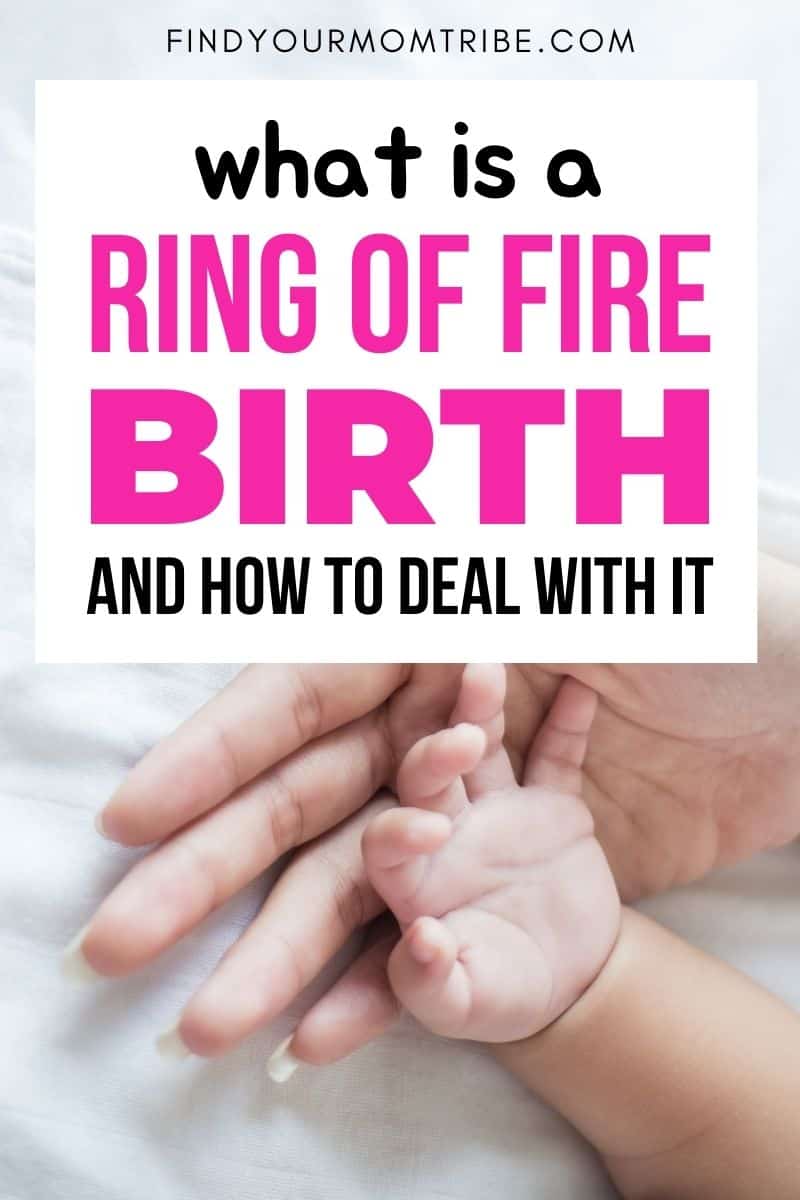Some people may think that the whole process of pregnancy is the biggest challenge a mom is going to face, but truth be told it’s the ring of fire birth part that’s the toughest one.
A ring of fire birth is the part of labor where the mother can feel the baby crowning in her birth canal during a full dilation. It earned this name from the burning sensation that is often felt during this process.
This is generally one of the final parts of delivery and happens just before the point where you’re going to be able to meet your little one face to face for the first time, so to speak.
It also marks the end of your pregnancy, a point where you get to return to the regular schedule that you had before your pregnancy, except this time you’re going to have another person under your roof.
And, whether you’re a new mom or a veteran one, the feeling afterward will be relieving, rewarding, and most of all, joyful.
But, one must first get through the ring of fire birth process, so let’s see what it entails, what potential complications can arise from improper procedures, how to minimize the chances of them occurring, and how to react properly in the situation.
How Baby Crowning Feels When It Happens

As I mentioned before, the sensation that most women feel is a strong burning one that’s followed by bouts of stinging pain should your vaginal opening stretch in an uncomfortable way.
But, some women have also reported that the pain becomes so great that it eventually just transitions into a dull, numbing one.
That’s because the nerves alongside the skin become so stretched that they end up being unresponsive to the point of numbing to prevent the brain from getting overwhelmed.
That said, women who have taken an epidural may feel a slightly dulled down burning sensation.
The sensation that replaces it is more of a pressure, a weight that you feel because your baby has started traveling down the birth canal.
Finally, you may be one of the lucky ones as some women experience very little to no pain at all meaning they get to avoid the ring of fire during birth almost entirely.
Should you experience a lot of pain or are having trouble with delivering your baby, you may want to try for an induced delivery, though the process of an induced delivery takes a bit longer than an unassisted vaginal delivery.
Don’t worry though, any and all of these feelings are expected and shouldn’t lead you to worry. It’s just a natural part of the birthing process.
When Does The Ring Of Fire Birth Actually Occur?

To understand this question, we must first go through the 4 different phases of labor and delivery.
These are:
1. The early stages of labor and the most active one
2. The descent of the child down the birth canal which is the actual birthing process
3. The delivery of the placenta after the birth
4. And the postpartum recovery process
The phase we’re looking for is the second one. That’s where the fabled ring of fire birth process happens.
It occurs when you become fully dilated which marks the end of early labor, after the initial bout of contractions which lasts from several hours up to nearly a day or two at worst.
Luckily, the actual ring of fire doesn’t last too long and, if you’ve reached this point and you are following the instructions given out by the medical doula and the ones you’ve picked up during labor training, you should pass through it with no issue and within a couple of contractions.
The best part about this is that you finally get to see your little one when the baby’s head pops out of your birth canal which tends to evoke different emotions in moms.
Some moms find it motivating when they glance upon their child’s pretty little head while some get overwhelmed with stress if they’re worrywarts.
Some even find the general idea of looking at what’s going on between their own legs to be a disturbing experience so they tend to look away.
Again, whichever one you experience, know that it’s perfectly natural. Just do what seems the most comfortable for you.
7 Things You Should Keep In Mind To Make The Ring Of Fire Birth Process As Smooth As Possible
Now, while you should try getting yourself comfortable, there are a few things you ought to keep in mind so as not to create any potential risk and problems for yourself when delivering your child and afterward.
These are:
1. Coming in prepared for the pain

The best method of pain relief is being prepared for the pain. This can come in the form of both physical and mental preparation.
Take some Lamaze classes if need be or simply go straight to the source and ask your doctor or other moms for what methods are recommended and what methods worked for them.
The more accessible ones usually involve an epidural to help dull the pain during labor, a perineal massage here and there to help prepare the area and loosen it up so it isn’t as tense during labor.
Even some deep breathing techniques are highly recommended to help you with proper air circulation to keep you calm and collected during delivery.
Then you also have the options of local anesthesia or nitrous oxide to help put you under during the delivery, although, those are a bit less recommended unless you’re in a lot of pain.
2. Not straining yourself too hard

Many moms tend to make the mistake of pushing after they see their baby’s crown only to end up straining their body harder than it needs to be.
It’s actually best to take it slow and to stop pushing to help prevent your perineum from suffering tearing or any other lasting damage from overexertion.
3. Relax

The best thing you can honestly do in this situation is to relax, breathe and think of all the stuff you have planned for your child once he comes out and you finally get to hold him in your arms.
Your baby won’t go back in once he’s started poking out so you shouldn’t worry about having to put in extra work just because you’re relaxing. Nobody is rushing you to deliver as quickly as is humanly possible.
Your safety and overall well-being are just as important as the baby’s in this case.
4. Finding the best position for child delivery

It’s not all about the deep breathing exercises and other relaxation techniques. Some moms find that taking a position different from the default helps them out immensely during the process.
You may be someone who just isn’t comfortable lying on your back and trying to push your baby out into this world.
Maybe you’re the type of mom who finds it easier if you’re turned on your side or even in a more reclined, semi-sitting position so you can observe your surroundings and be more aware.
Or, you may even be the type who prefers delivery on all fours. Yes, there are women who find that position one of the most comfortable, and it’s nothing to be ashamed about.
Whatever the case may be for you, know that ultimately, all of this serves the purpose of finding what methods help make you the most comfortable and the process as painless as possible while making sure that the birth experience is safe for your little one as well.
5. Listening to your doctor

If you didn’t take part in any delivery training or you’re having a difficult time remembering the advice you did receive from studying up on it prior to delivery due to stress or any other factors, your best bet is to listen to the doctor present at the time of delivery.
He’ll be there to calmly guide you through the process and adjust the pushing periods based on the child’s position when the baby’s head crowns, and your level of strain.
Do that and you should mitigate the pain that you might have experienced in and around your cervix and deliver your baby without issue and within a timely manner.
6. A C-section isn’t a death sentence

If the child’s body is deemed too large to go through a regular vaginal birth due to your dilation being insufficient at the time of delivery, you are bound to have to resort to a C-section delivery in order to prevent any serious damage to your vaginal tissue and your perineum.
But, just because you won’t experience a natural childbirth doesn’t mean it’s the end of the world. A C-section is just as normal and is a last resort in order to help both you and your future child to come out of the process as unscathed as possible.
The worst thing you’ll experience is scarring which should heal properly after a few weeks.
7. An episiotomy as an alternative to a C-section

The other method you can employ is an episiotomy.
That’s a procedure where the doctor makes an incision on your perineum to help artificially extend the dilated area. This can help you deliver the baby should his shoulder get stuck if he is in a poor position as he comes out of the birth canal.
While not the most ideal alternative due to its own potential complications, it’s still a lifesaver for both you and the baby, especially if you have a baby in distress. It may, however, cause some issues if it doesn’t heal properly.
Make sure to schedule an appointment with your doctor should there be any issues in your perineal area postpartum.
The Potential Complications That May Occur During The Ring Of Fire Birth Period

Note that even with all of the necessary precautions being taken, you’ve only minimized the risk of potential injury, not nullified it. It’s still there, no matter how small, and you should be prepared to know what to expect should things go wrong.
The main problem you’ll encounter are the various tears that can occur during the ring of fire birth period that affect up to 70% of moms, regardless of whether or not they’re experienced or first time moms giving birth to their first baby.
Now, there are some which happen often, that will not require special procedures.
We call these the first and second degree tears.
The first degree ones generally encompass the perineal area since that one is most likely to tear while the second degree ones include both the perineum and the vaginal tissue itself.
While painful, and sure to deliver a very unpleasant stinging sensation of varying degrees depending on how harsh the tear is, both of these should heal within a few weeks with the second degree tear potentially requiring a few stitches here or there.
If you find the pain too unpleasant, you may want to get some pain relief medication, but you should ask your doctor for an opinion first and describe the sensation to him as it’s better to go unmedicated than to cause potential issues by ingesting painkillers whose content may mix with your breast milk.
There are still two other types of tears and they’re the third and fourth degree tears.
The third degree tears are the ones affecting both the perineum and the muscle around the anus, causing potential incontinence and severe pain.
Muscle tears are no joke and if you start experiencing any issues similar to those above, contact your doctor for further instruction immediately as you may require a surgical procedure to fix the issue.
These types of tears will rarely heal on their own, the same goes for the fourth degree ones. Speaking of which, the fourth degree ones are the worst kind of tear you can experience and, thankfully the rarest of the bunch.
They’re the ones that affect the perineum, the sphincter itself, and the protective mucus lining inside of the rectum.
Should those become compromised, you may potentially be in grave danger and should urgently contact your doctor so that you can undertake surgery as soon as possible.
Naturally, should you go through a surgical procedure, it’s understandable that the recovery time becomes a lot greater, but it’s all with the purpose of keeping you healthy.
In Conclusion
A ring of fire birth is part of the labor process where you’re likely to experience a lot of labor pain.
The key to overcoming it is learning how to manage it while also making sure that you aren’t forcing yourself too hard which could accidentally cause a tear around your perineal, anal, or vaginal areas.
Just stay calm, relax, and breathe. Make yourself as comfortable as you can and remember that the doctors are your best friends during this period.
They’ll make sure to guide you through this and minimize the burning sensation that you might possibly be feeling throughout the delivery process.
All you have to do is stay focused and you should be able to overcome this final hurdle in your pregnancy period and see the hard-earned fruits of your labor by looking at the face of your precious little bundle of joy.
Like this post? Please share or pin it for later. You can also stay in the loop and follow us on Facebook, Instagram and Pinterest.

This post contains affiliate links. Please see our full disclosure for more info.

